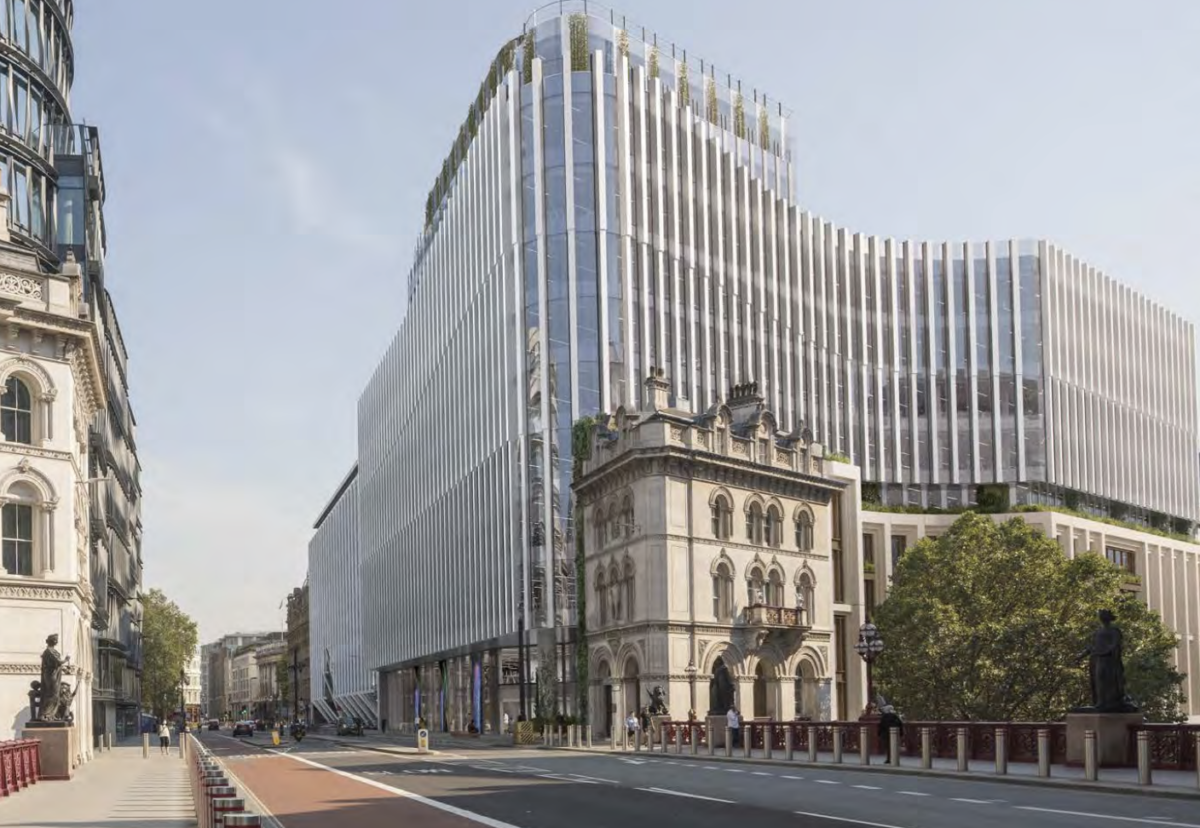
Category: News | December 14, 2021
An office-led development on Holborn Viaduct has been given the green light by the City of London Corporation. The scheme sits across two levels on Holborn Viaduct and Farringdon Street. The scheme will stand 10 floors tall on Holborn Viaduct and 12 floors on Farringdon Street.
Developed by Royal London Asset Management, it is targeting Breeam Outstanding and will provide almost 36,000sq m of office floorspace. It also includes the grade II south-eastern Gatehouse – one of four standing either side of the Holborn Viaduct bridge. A new lift is also planned to carry people from Farringdon Street up to the bridge. At present, the only way to get up to the top from the street is via the steps in the gatehouses. The development includes 499 long-stay and 34 short-stay cycle parking spaces. There will also be cargo-bike parking facilities and a “wellness hub” with lockers and showers for office occupiers.
Martha Grekos, Chair of the Public Realm and Environment Group at Fleet Street Quarter, said: “The current buildings – Kimberley House, Meridian House and 32 Farringdon Street – offer an unremarkable and uninspiring aesthetic to the area, with outdated façades, narrow and constrained floorplates and a lack of permeability. Although Fleet Street acts as the geographical spine for our Partnership, the Fleet Street Quarter embraces a much wider area, with Holborn Viaduct acting as our northern boundary and thus a key gateway moment to the wider Quarter. The redevelopment of the three buildings proposes some instrumental improvements to the public realm, through the animation of the streets by introducing active frontages on both Holborn Viaduct and Farringdon Street and increased permeability. The new public spaces, joined by a lift, creating a new step free link between Holborn Viaduct and Farringdon Street, is particularly welcomed, creating an inclusive space.
The current Fleet Street Quarter lacks open and green spaces that promotes dwell opportunities. The new streetscape of the proposed redevelopment provides greening with planters and trees that enhances the quality and usability of public realm, creating a better micro-climate and reducing the urban heat island effect. Green infrastructure can improve air quality by providing barriers to sources of pollution such as busy roads and in turn counteracts the urban heat island effect. Rising evidence also suggests that investment into green infrastructure can in turn provide tangible benefits to local occupiers. In the short-term, co-benefits of greening will create pleasant spaces that encourages people to stay longer and engage more with their surroundings. This not only is a positive thing for the local area but adds to the vibrancy and character of the Quarter boosting peoples’ wellbeing. The planters integrate bench seating, providing places for the public to stay and enjoy.
We recognise that existing commercial buildings, built by previous generations, often cannot meet the environmental or operational standards required by modern users, and believe when redevelopment is necessary, developers should seek to deliver the highest quality proposal, deploying the principles of the Circular Economy to ensure maximum benefit to the City. At a time of great focus on sustainable development, it is right that the developer seeks to achieve BREEAM Outstanding and has designed a building that is capable of adaption to respond to major changes of uses over its lifetime. These are impressive targets, befitting a city which places extreme importance on climate action. The proposals for the wider public realm, including planting in Farringdon Street and the provision of publicly accessible cycle parking, will ensure those visiting the wider area benefit from the improvements delivered by this scheme.
A thorough and attentive cultural audit has been undertaken for the development, offering a cultural strategy that will broaden the use of the building. The cultural strategy for the development invites a varied demographic to make use and visit the space, contrasting to the heavily corporate environs in the surrounding area. The developers are committed to a series of external public art that will run during the development stages and beyond. Proposed external public digital art screens provide the opportunity to showcase art pieces in a 24/7 capacity, making visual connections and conceptual connections across the site. It is also noted that the developers will be looking to work with the Museum of London, that can create an organic link between the Fleet Street Quarter area and the Culture Mile. The cultural strategy not only considers local perspective but also seeks the ambition of the global stage through acknowledgment of the Mayor’s London Plan (2021).
Whilst the scheme will primarily look to appeal to it building occupiers, there is consideration for the building responding to a wider audience that can be interacted with and used beyond ‘working’ hours. Fleet Street Quarter is supportive of the development of Holborn Viaduct. We believe the introduction of a new, highly sustainable, flexible office building will both drive the economic vitality of the City as well as deliver tangible benefits for the local area through the provision of public realm and accessibility improvements, new public art and a cultural strategy, and extensive greening and planting – aligning with the ambitions of the Partnership and its members.”
Original press release can be found here.

